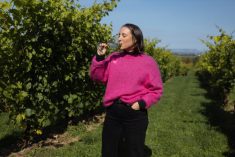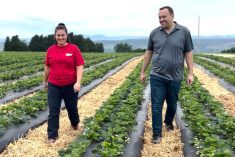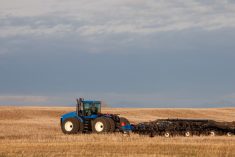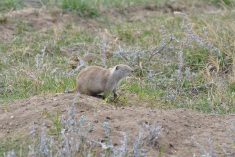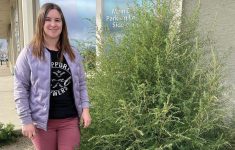A panel of judges will be faced with a difficult challenge in Saskatoon later this month as they look to select two national winners from a field of seven diverse, well-managed farming operations from across Canada.
From tree fruit production to grass-fed beef, mixed farming to organic crop production, and dairy farming to potato production, the 2022 nominees represent a diverse lot of first- to sixth-generation agricultural enterprises.
After winning regional Outstanding Young Farmers competitions earlier this year, they will all meet in Saskatoon Nov. 23-27 for the national awards event.
Read Also
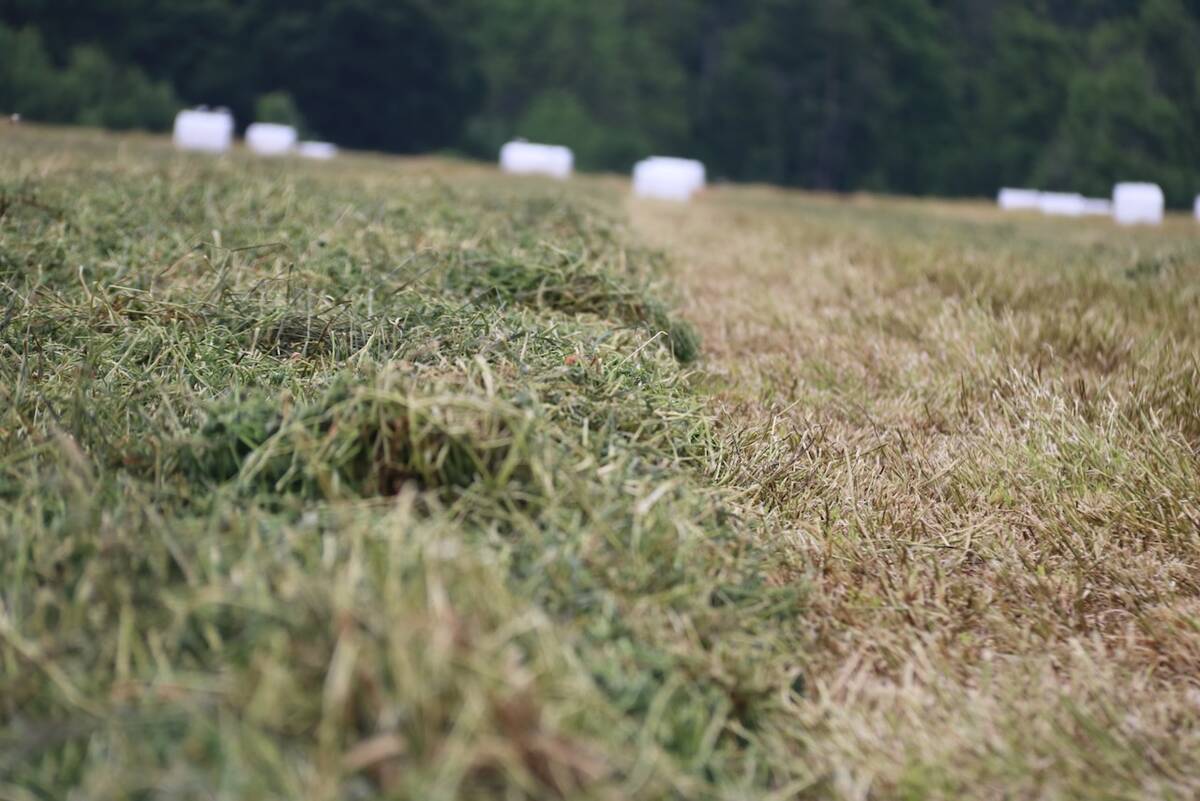
New high-performance forage training program to launch in 2026
A new Canadian Forage and Grasslands Asssociation high-performance forage program will be a resource for farmers, agronomists and others in the forage sector.
Gurpreet Lidder – British Columbia
Fruit producer Gurpreet Lidder of Lidder’s Produce Ltd. is British Columbia’s Outstanding Young Farmer for 2022.
Lidder, in partnership with his parents Dave and Satpal Lidder, operates an 80-acre fruit farm near the B.C. Southern Interior community of Keremeos. The family started with a 10-acre operation in 1992, and continued to expand. Growing up on the fruit farm, Gurpreet completed his business degree at Okanagan College, returning in 2003 to what was then a 35-acre operation.
While his initial goal was to develop a profitable farming operation producing high-quality fruit for the roadside market, with further expansion in fruit production he now supplies a wholesale market as well with a variety of fruits including apples, cherries, peaches, watermelons and pears.
Lidder applies careful management to all aspects of the farm operation from fruit production to shipping. Optimal fertility, for example, is key to fruit growth and quality. He monitors crop nutrient levels carefully with soil testing, along with tissue and fruit analysis during the growing season to adjust any nutrient shortcomings as necessary.
Lidder says some of the key elements of a successful business are to have good communication with all of those involved with the farm, follow proper safety protocols and produce consistent and high-quality produce that earns the trust of customers.
Ben Campbell – Alberta
Ben Campbell started out with a career in engineering before deciding to follow in the footsteps of his grandparents and get involved in the ranching industry.
Born and raised on the family-owned Tullichewan Ranch near Black Diamond, just south of Calgary, Campbell says he wasn’t raised as a ranch kid. But it was after working in Africa with an organization known as Engineers Without Borders that he decided he wanted to make a more personal and direct contribution to society.
“I didn’t know what I wanted to do, but I was looking for something that had a greater value to society than just earning a living for myself,” says Campbell. It was almost by chance during a conversation with a friend that the idea of grazing cattle was discussed. “And I thought why not give that a try,” he says.

To get started, he rented part of the ranch, which was established in 1955 by his grandparents John and Elizabeth Campbell. From there it was a steep learning curve.
“I didn’t know anything about cattle or pasture management. I didn’t even know how to ride a horse,” says Campbell. “I had to learn everything from scratch. But this was something we wanted to do so we worked at learning about the ranching business.” His commitment to learning and developing a well-managed beef operation earned Campbell recognition as Alberta’s Outstanding Young Farmers regional nominee for 2022.
In 2013, Campbell and his wife, Steph, bought their first four yearlings. They finished them on pasture and then marketed the beef directly to customers in nearby Calgary. And the ranch has grown from there.
Today, the ranch still has the direct marketing side of the business branded as Grazed Right beef. The couple finish between 25 to 30 head of purchased two-year-old steers on grass, have them processed and direct marketed to customers.
As well, they run about 300 head of yearlings, which are bought in the spring, raised over summer and fall through an intensive rotational grazing system and then sold into the commodity beef market in the fall.
“We have two main pillars to our farming operation,” says Campbell. “One is to apply the best animal welfare practices in all aspects of beef production. We have worked hard and continue to learn about and apply low-stress livestock handling practices. And we are also concerned about following proper environmental practices as well. We want our grazing operation to have the lowest impact on the environment as possible.”
Today, as they own 320 acres of deeded land as well as 1,200 acres of rented grazing land, cattle are managed in a high-intensity, short-duration rotational grazing system. “They are on and then off any particular pasture,” says Campbell. “We move cattle every day. Our plan is that every acre of the ranch is grazed only for one or two days per year.”
With a combination of tame as well as native pasture, their program is working to increase plant biodiversity, while at the same time improving soil health. The couple have also developed off-site water systems to keep cattle away from natural water sources such as creeks and riparian areas.
“We are developing a grazing system that mimics how this area may have been grazed at one time by bison,” he says. “It is a business but it is also a way of life, a good place to raise our family, with a beef production system that works with and benefits the environment at the same time.”
Cody Straza and Allison Squires – Saskatchewan
Cody Straza and Allison Squires are planning over the next few years to improve production efficiency on their certified organic mixed farming operation in southern Saskatchewan.

The couple launched into organic farming in 2010, which today consists of about 4,500 acres of annual cropping, complemented by a 300-head cow-calf operation, at Wood Mountain, about two hours southeast of Swift Current and about 30 minutes north of the Montana border. Their management skills in developing Upland Organics Ltd. earned them recognition as Saskatchewan’s Outstanding Young Farmers regional nominee for 2022.
“I think we have the size of operation now that we can manage, so the goal is to get better and not necessarily bigger,” says Straza, who was born and raised on a farm in the Wood Mountain area. While Squires, who has a PhD in toxicology but readily adapted to the farming life and career, says they want to keep improving on what they have as well as look to build a more secure supply chain. “The pandemic showed us the weaknesses in the supply chain, so going forward, perhaps, we can look at ways to fill those gaps and mitigate some of the supply chain limitations on more of a local or regional basis,” she says.
The couple met while they were pursuing different studies at the University of Saskatchewan. Straza was studying to be an agricultural engineer, while Squires, who was born in Newfoundland and grew up in Guelph, Ont., came to Saskatchewan to finish her studies, obtaining her PhD.
“We met at university, and I worked for a couple of different companies as an agricultural engineer,” says Straza. “Then in 2010, the opportunity came along to buy a farm in the Wood Mountain area where I grew up and we had to make a decision. Do we stay in Saskatoon or do we take the leap and go farming?” They didn’t have to think too long — the farming idea clearly appealed to both.
The couple bought a neighbouring farm not far from where Cody’s parents also farm. It had been a longtime beef operation, so in relative terms it was fairly easy to convert that farm to an organic cropping operation without a long delay in obtaining organic certification.
Today, the crop rotation on Upland Organics Ltd. includes flax, lentils, durum wheat, Khorasan (an ancient wheat), sunflowers, camelina, chickpeas, yellow mustard and peas. And production practices include intercropping, relay cropping and companion cropping as well as some acres seeded to season-long cover cropping.
“We grow different combinations of crops that complement each other,” says Straza. Intercropping can include a cereal crop seeded with a legume to add nitrogen to the soil, lentil seeded with flax, or peas seeded with oats. Relay cropping can involve a spring crop seeded with a fall crop such as fall rye. The spring crop is harvested the first year in September while the fall rye is harvested the following year. And companion cropping might include a cereal crop underseeded to a legume. The season-long cover crops are seeded in the spring and then grazed by livestock, before an annual crop is direct seeded into the stubble the following year.
“As much as possible, we have worked to reduce tillage and direct seed as much of the farm as possible,” says Straza.
Their farming practices, which include seeding crop combinations, crop diversity along with cover cropping and livestock production, qualified Upland Organics to receive a relatively new, holistic standard known as Regenerative Organic Certified.
“It recognizes three main pillars — a commitment to improve soil health, proper animal welfare practices as well as social fairness and social justice,” says Squires. “The farm reflects our values, and since receiving this certification we’ve also been approached by some markets also looking for those values.”
And Squires’s education in toxicology, which includes chemistry and biology, is also being incorporated in Upland Organics. Over the years, they have established a research component to the farm, collaborating with different agencies such as universities and Agriculture and Agri-Food Canada running large-scale field trials. They also now have a laboratory on the farm for conducting toxicology and tissue testing. And the couple is also interested in conducting some research in livestock production efficiency.
“Once our family is a little older, my dream is to focus more on the research component,” says Squires. “Both of us are lifelong learners, so we are always interested in challenging ourselves in trying something new.”
Richard and Kristy-Layne Carr – Manitoba
When the opportunity came along in 2017 for south-central Manitoba farmers Richard and Kristy-Layne Carr to get involved in dairy farming they grabbed it.
The couple had been increasing beef production for several years, building up to about 250 head along with 1,000 acres of crop and pasture land near Marchand, about 82 kilometres southeast of Winnipeg. To complement the livestock operation, they diversified into direct marketing of beef, and added poultry and pork to their production. Their emphasis was on marketing meat products through farm gate sales and farmers markets. Richard also worked off farm and at the same time they were raising a young family of four kids all under the age of five. Life was pretty hectic and the farm still hadn’t reached the scale to allow the Carrs to be full-time farmers.

“We were at a point where there was too much going on,” says Kristy-Layne. When their lender suggested they make an application to the Dairy Farmers of Manitoba new entrant program they figured it was worth a shot. Richard, who was born and raised on a dairy farm and had worked as a herd manager for several years as well as a livestock nutritionist, had the background, while Kristy-Layne had come from a beef background.
It was a detailed dairy application process, but in December 2017 it was announced they qualified for the new entrant program. That allowed them to acquire 30 kilograms of producer-owned quota as well as 30 kilograms of board-loaned milk quota. That quota was enough to give them a good start in the dairy business.
After a few hectic months, which involved downsizing the beef herd, selling some of their land base, and designing and finding a contractor to build an affordable dairy barn with a used double-eight milking parlour, they milked their first cow on Aug. 1, 2018.
Today, Rich Lane Farms consists of 55 head of Holstein milking herd, along with a 60-head Angus-cross commercial cow-calf operation. The farm has about 160 acres of deeded land, used primarily as pasture for the beef herd, and another 240 acres of rented cropland where they produce silage corn, alfalfa, millet, forage oats and ryegrass.
“We are a small operation by industry standards,” says Richard. “But we have the numbers to allow us to be full-time farmers.” Aside from one part-time worker, who primarily helps with milking, the family manages the farm and workload themselves. The couple’s ability to apply sound management to develop the mixed dairy and beef operation earned the Carrs recognition as Manitoba’s Outstanding Young Farmers regional nominees for 2022.
The past four years has allowed the farm to settle into somewhat of a production routine and to concentrate on improving production. “The dairy is at a manageable size for us, so the focus has been on increasing milk production and quality,” says Richard. Milk production right now is averaging 37 litres per cow with 4.5 per cent butterfat content. The herd produces an average of 1.6 kilograms of butterfat per cow, with a somatic cell count of 100,000. The farm also has a dairy herd reproduction rate about double the industry average.
While initially they relied on custom operators for most of the field work, in the past couple of years they are using their own equipment to put up feed. The last couple of growing seasons have been a challenge — 2021 was one of the driest growing seasons on record, while 2022 was one of the wettest. “You know you’ve got problems when you’re trying to chop corn and in a nearby pothole the swans are swimming,” says Kristy-Layne.
The Carrs are more than willing to share their farming experience with others. Both Richard and Kristy-Layne are active on social media such as Facebook, Instagram and Twitter, and in 2021 they started a YouTube channel called The Big Small Farmer.
The YouTube handle not only reflects the size of the farming operation but also the size of the farmer. “The farm is small but I’m six feet nine inches (tall) so I’m a big farmer,” says Richard. “We feel it is important to be open and share what we do not only with other farmers but with consumers in general. If we can connect with a consumer and help them have a better understanding about what farming is about, then it is all worthwhile.”
David and Jennifer Vandevelde – Ontario
Market gardeners David and Jennifer VanDeVelde, from Wholesome Pickins Market and Bakery located at Delhi, were named Ontario’s Outstanding Young Farmers for 2022.
Both University of Guelph graduates, David and Jennifer returned to the family tobacco farm in 2006. Established in 1930, the farm is located on the east side of Delhi, just a stone’s throw from Lake Erie.

They chose to use their education in horticulture — David with diplomas in agriculture and horticulture and Jennifer with a bachelor of science degree — to take the farm in a different direction.
The VanDeVeldes began growing strawberries in 2005, and in 2007 added everbearing strawberries to the fields. The heart of the business remains strawberries, and it is the everbearing berries that begin producing in late May and continue to bear large-sized, bright red fruit until Thanksgiving. As they continue to expand production, the business has seen many changes over the years, including the creation of Wholesome Pickins.
With the excellent soil and growing conditions of Norfolk County, Wholesome Pickins produces more than 200 acres of crops, including strawberries, asparagus, raspberries, pumpkins, rhubarb, tobacco and a variety of field and cover crops.
The operation continues to expand the retail farm market and scratch bakery each season, adding a range of food products produced with local ingredients. The VanDeVeldes believe in supporting other local farming operations.
“We also provide Norfolk’s best-tasting sweet corn, new potatoes, sweet potatoes, tomatoes, peppers, green and yellow beans, cherries, blueberries, cucumbers, asparagus and other in-season fruits and veggies, all grown by our friends and neighbours,” says Jennifer.
Also this year, Wholesome Pickins carried cheese products manufactured by Jensen Cheese in Simcoe; hotdogs, sausages, frozen hamburgers and steaks from VG Meats; honey from Harmony Hives as well as a variety of peanuts, nuts and snacks from Kernal Peanuts in Vittoria.
“Everything sold at Wholesome Pickins is fresh from a Norfolk County farm because we believe it is important for consumers to know where their food comes from,” says David.
The couple is also actively involved in the Ontario Berry Growers’ Association — Jennifer is the new vice-president and David is the treasurer — as well as the local community.
Étienne and Guillaume Lessard – Quebec
Brothers Étienne and Guillaume Lessard, who own and operate a dairy farm in southeastern Quebec, are that province’s Outstanding Young Farmers regional nominees for 2022.
Étienne and Guillaume are the fourth generation on the family farm, Ferme Holdream, at St-Honoré-de-Shenley about two hours south of Quebec City. Along with dairy they produce cash crops, organic pork and organic maple sugar.
The brothers took over operation of the farm in 2006. The dairy sustained a major blow in 2018 when fire destroyed the main barn along with 200 head of dairy cows. Fortunately, heifers and calves were in a separate building and survived. They became the nucleus of rebuilding the herd.

Down but certainly not out, the Lessard brothers were determined to rebuild. They lined up contractors, took the opportunity to design a modern and expanded dairy facility and began the rebuilding process. With the help of neighbours, who housed some of their cattle during the construction, the dairy was back in operation in the new barn one year later in October 2019.
The new facility was designed to accommodate robotic milking technology that operates 24 hours a day. The dairy resumed production with 190 head of lactating animals and about 280 head of dry cows and heifers and four robotic milkers. However, the brothers had plans to quickly increase the milking herd over the next few months. The barn was designed with a capacity for up to 390 head of lactating cows and two more robotic milkers.
Morgan and Karissa Smallman – Atlantic Canada
As the 2022 Atlantic Canada nominees for Canada’s Outstanding Young Farmers award, Morgan Smallman and his wife, Karissa, know the meaning of being prepared for the unexpected.
As longtime potato growers near Knutsford on the northern end of Prince Edward Island, they had to deal with the effects of the 2021 potato wart outbreak on the Island and earlier this fall they had to weather the winds and rain of tropical storm Fiona as it blew across the East Coast of Canada.

“That’s the first time we have seen a storm like that,” says Morgan, during an early October interview as the potato harvest was just getting started. “There were heavy rains and we had some buildings damaged by the wind, but overall we came through it pretty well, some areas certainly had it much worse.”
Since the storm passed, the sixth-generation family farm, J and J Farms Ltd., was enjoying clear and cool weather as they began harvesting about 400 acres of potatoes, which will be marketed into what’s known as the chip stock potato market. Eventually their crop will be processed by snack food manufacturer Frito-Lay Canada.
Along with Morgan and Karissa, the farm is also owned and operated by Morgan’s father, Jeff, and his uncle, Jason. It was a longtime mixed farming operation that has “grown potatoes forever” but switched to full-time potato production about eight years ago. Morgan, who describes his dream job as being a “smart farmer,” obtained a degree in economics from Nova Scotia Agriculture College, then worked as an agronomist for a time before returning to the family farm full time in 2014.
Over the past 10 years or so, the owners have focused on improving potato production efficiency, while at the same time applying practices that protect and improve soil quality.
Morgan follows a three-year crop rotation that includes two years of a grass/legume forage stand followed by potatoes. “We want to keep the soil covered and at the same time return nutrients to the soil,” he says. He had used an annual cereal crop in rotation as a cover crop in the past, “while grain covers the soil it does remove nutrients,” he says. The grass/legume forage cover crop adds more to the soil.
For the forage cover crop, about 400 acres is seeded to sorghum-sudan grass underseeded to alfalfa. In year one, the sorghum-sudan grass will be cut and just left on the fields. In year two, the alfalfa crop takes over and is eventually plowed down before the potato crop is seeded. “We are already seeing improvements in soil quality,” says Morgan. “The forage crops are adding organic matter to the soil and the deep-rooted alfalfa is reducing soil compaction.”
Along with potato production, Morgan also has a custom trucking business with three tractor trailer units on the road and he is also a sales agent for the nearby Trout River Industries, which manufactures rear-lift and live-bottom truck boxes and Hycube trailers.
Morgan says while they will continue with the production system they have, the next major project involves adopting an improved record-keeping system. “Things are always changing and there is always new technology,” he says. “Particularly since potato wart, it has become necessary to have full traceability throughout crop production, storage and as it leaves the farm.” Working with Ontario-based Greentronics, he plans to be outfitting the farm with hardware and software needed for a complete field management and record-keeping system.




